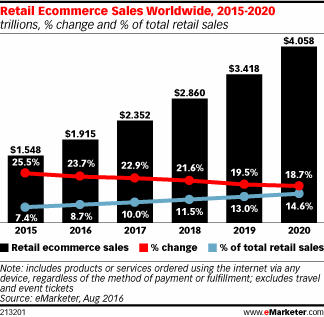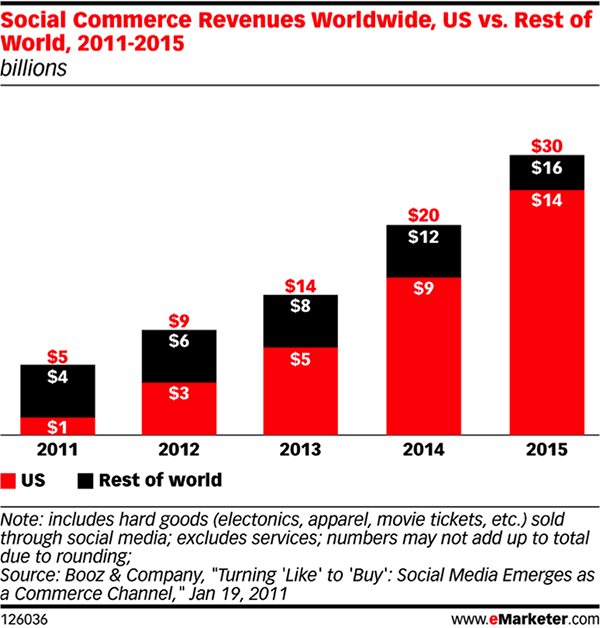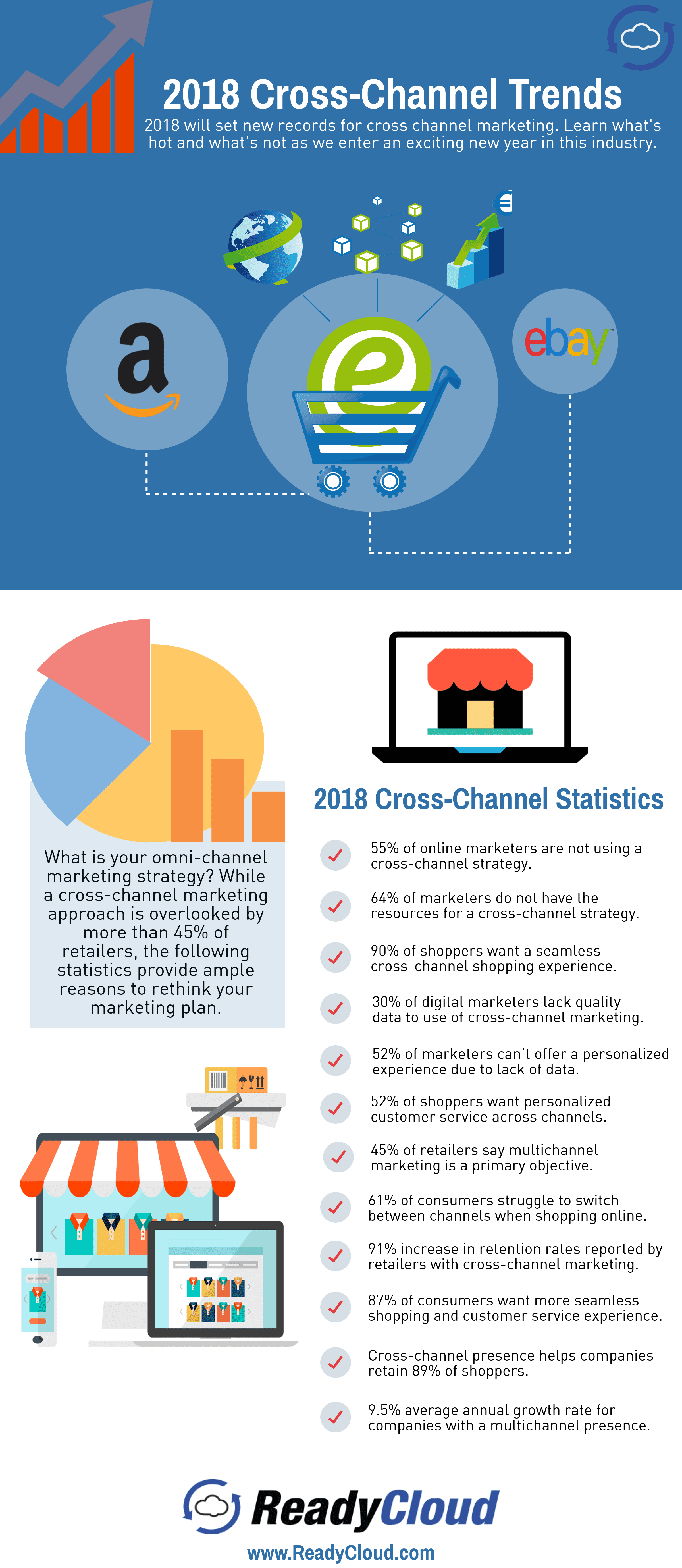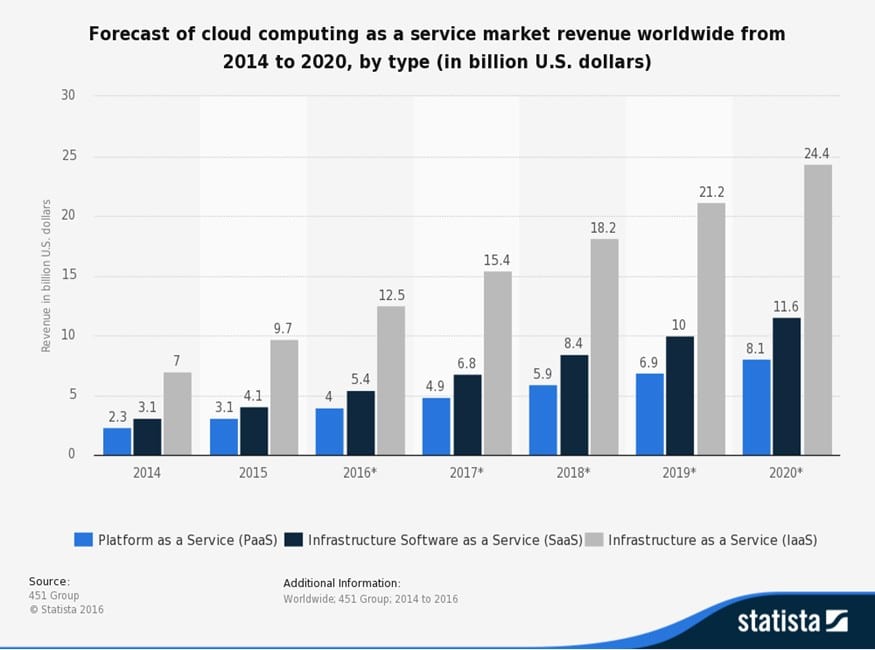2017 Ecommerce Technology Trends to Watch

It’s almost time to celebrate the long awaited holiday season. For online retailers, this is usually the most exciting and also the busiest time of the year. The holiday shopping rush runs nearly to Christmas Eve. Following that, the returns rush dominates. This turns full circle come mid-January, when New Year’s sales once again drive shoppers in droves to their favorite online stores and marketplaces.
Read on to learn more.
According to eMarketer, ecommerce represented 8.6% of all retail spending in 2016, accounting for an estimated $1.915 trillion of a staggering $27 trillion pot. China led the pack, hauling in $899.09 billion (about 47%) of the total ecommerce haul for 2016. But North America is on track, too, with a $423.34 billion haul, and a healthy 15.6% increase year over year to end 2016.

As we gear up for yet another exciting, record-setting year, what ecommerce technology trends should we be focused on? We’ll get you a step ahead with this forward-thinking outlook. Some of the latest ecommerce trends you may already be familiar with. Others may be new to you. Either way, they’ll all be in the spotlight over the next four quarters.
Ecommerce Technology Trends to Follow in 2017
- Drone delivery: This fascinating new delivery method is already being tested and is in the works, found in the form of Amazon Prime Air. It could usher in a new era of delivery, with hourly delivery of your purchased goods directly to your backyard. But there are a few regulatory hurdles that need to be overcome first.
- Smart button ordering systems: Amazon’s popular Dash Button subscription ordering method is already a hit for consumers. It’s only a matter of time before this becomes one of the more notable ecommerce technology trends.
- One-click mobile shopping carts: Mobile shopping carts tender about half of all sales, many which are fed by mobile couponing. But one-click mobile shopping is about to change everything, and caters the shopping experience to user’s habits and tendencies instead of impulse purchases.
- Digital wallets: Payment providers are racing to buy up every digital wallet they can. PayPal bought Paydiant last year for $280 million. With contenders like Apple Pay, Samsung Pay and Google Wallet in the mix, this market will continue to heat up because it offers a secure and wireless payment option.
Social Commerce is the Next Big Thing
Of the most pivotal trends in ecommerce to follow, social commerce is the most exciting. This emerging shift in ecommerce combines social media with an ecommerce engine, as is seen in the Facebook Marketplace and in socially inspired shopping engines like Polyvore.
But unlike Polyvore, an online catalog and social shopping engine, or Facebook Marketplace, which is essentially a glorified social media take on Craigslist, social commerce is quite different. A good example can be found in the Shopify function that allows you to bring your store online and integrated into your Facebook brand page.
Social commerce enables an ecommerce marketplace or store inside of a nested social media site. It’s a great way to expand a brand’s reach and saturation while aiding in making social media brand ambassadors of your most loyal customers. Key trends in this arena include: Polls, online reviews and tagging or sharing of recently purchased goods.

As the chart above inflects, social commerce has become a major player in the ecommerce arena. Between 2011 and 2015, social commerce grew from $5 billion to $30 billion. Think tanks are projecting that over the next five years, this will increase to $100 billion in spending per year or more.
According to the most recent social commerce trends for 2016, ones that will easily crossover into 2017, social media represented 5% of all ecommerce shopping. Experts are forecasting a whopping 25% growth over the next few years, with mobile ads powering the engine of growth, according to current social commerce statistics. Given that social media plays a central role in many people’s lives, this trend is unsurprising.
Software Trends
The big question of the day is: What trending technologies will dominate in ecommerce? For retailers, there are a number of software applications that they rely on daily to run their business.
Aside from the cloud-based shopping cart or marketplace that hosts their online store, many also use a shipping software, returns software, inventory management software and accounting software solution.
A majority of online retailers are also likely using a newsletter service, a customer service integration and even a social media posting service. So what’s ahead for 2017 with ecommerce software?
- Software will evolve to meet retailers’ needs. This is not to say that the current batches of software are not getting the job done. However, an expanding technology hemisphere means that more innovation is yet to come. Intuitive solutions will take center stage, with self-learning programs and more complete automation.
- Free ecommerce software will become thing of past. While the free trial offer will certainly go away, the popularity of open-source ecommerce software is waning. WordPress really isn’t free if you need premium plugins, a shopping cart, a fulfillment system, hosting, a domain and more. Software makers are shifting focus to a monthly service solution that’s offered at a bargain price instead of a freemium solution. Gone will be the days of open-source freebies, and here will be the days of the $10 to $20 per month (or more) software solution.
- Web store software will focus on cross-channel integration. With a variety of shopping carts and marketplaces out there, retailers have to maintain an omni channel presence. But none of these systems talk to each other or share data. In will enter the cross-channel integrations (like ReadyCloud) that pull all the data from all sales channels to give retailers a complete picture of their online presence, trends and customer behavior.
- The cloud will become the new norm, period, as more companies buy and sell IPv4 addresses to accomodate for the drastic increase in traffic that’s yet to come. At the forefront of ecommerce software solutions will be the cloud. According to the most recent statistics compiled by Statista, cloud computing is set to earmark a $24.4 billion haul annually by 2024. For 2017, current predictions say that cloud computing will rake in $15.4 billion, increasing to $18.2 billion by 2018.
XaaS the New Pack Leader
A Search Cloud Computing article perfectly defines Everything as a Service (XaaS), explaining that: “XaaS is a collective term said to stand for a number of things including “X as a service,” “anything as a service” or “everything as a service.” The acronym refers to an increasing number of services that are delivered over the Internet rather than provided locally or on-site. XaaS is the essence of cloud computing.”
As it relates to ecommerce technology, XaaS is already widely in place. Think about it. Your shopping cart, marketplace account, accounting software, inventory management system, and even your shipping and returns software all, typically, are accessed via a website login. Cloud computing, in general, will become the mainstay for XaaS, especially for ecommerce retailers, who likely already rely on such services to begin with.
Mobile Marketing Will be a Central Focus
Retailers will have a strong eye on mobile marketing in 2017. According to Marketingland, 55% of traffic received by the leading websites online comes from mobile devices. With about half of all web traffic online these days originating from a mobile device (usually a smartphone handset) this makes sense.
As it relates to mobile commerce, Internet Retailer gives us the complete look at the scope of these numbers, explaining that 30% of all ecommerce sales come from mobile devices. With ecommerce generating an estimated $350 billion in 2016, of which about $100 billion came from mobile, it’s safe to predict that mobile will do around $105 to $110 billion in sales in 2017.
Naturally, this will be attractive to online retailers, who will make mobile marketing a central focus. According to the most recent mobile shopping statistics, mobile shopping apps, pay-per-click ads and video advertisements will be the big mobile marketing trends for 2017. An Invesp report makes a wild prediction that between 2016 and the end of 2017, over 2 billion purchases will derive from mobile commerce.
Cross-Channel Integrators
Revisiting a central theme of our ecommerce technology trends and predictions for 2017, cross-channel integrators will become more widely used, fed by software applications and cloud-hosted online services that connect all of a retailer’s sales channels to one central interface. With Forrester predicting $1.8 trillion in cross-channel sales for ecommerce over the year ahead, you can bet your bottom dollar on retailers racing to get in on this healthy pie.
“Direct eCommerce sales (including mobile and tablets) will top $370 billion by 2017 and that total retail sales in the US will reach $3.6 trillion by 2017, 60% of which will be either transacted directly on PCs, phones, or tablets, or influenced by research on those devices.”
Using a combination of the aforementioned ecommerce technology trends, expect next year to deliver a more robust and inclusive online shopping experience. For an in-depth look at what’s ahead as far as shopping trends, customer and retailer habits, make sure you take a look at our complete guide: Ecommerce Trends to Follow into 2017 for more insight.

Share On:










